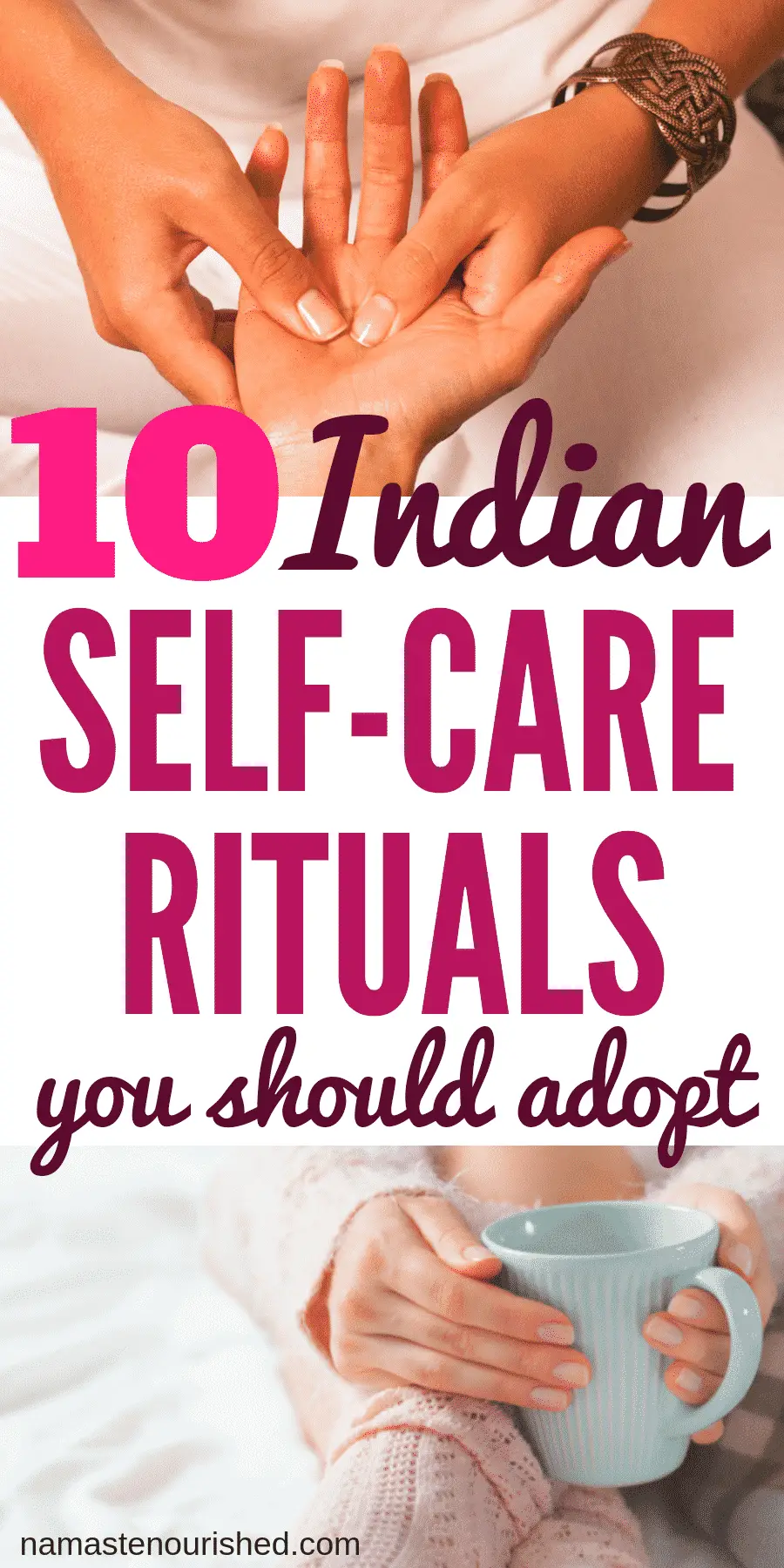If self-care isn’t a part of your daily routine, then I’m officially telling you that it needs to be something you do each day. And if you’re thinking to yourself something along the lines of “Yeah, right. I don’t have the time for self care!” then you’re the exact type of person who needs to begin practicing self-care right away. Trust me, this daily Ayurveda practice will help you start effective routines to change how you’re feeling very quickly!
Have you ever heard the expression “you can’t pour from an empty cup”? Stop and think about it for a second – how can you give of yourself to your children, work, family, business, education, etc., if you’re running on empty every day?
One of the core goals of the ancient practice of Ayurveda is to maintain health, which is why preventative self-care is a huge part of Ayurvedic medicine. Self-care rituals abound in Ayurveda, from the simple to the complex.

The good news is, there are many self-care rituals in Ayurveda that you can begin implementing into your life in a few minutes. And everything listed below can be part of a daily routine that will help you feel healthy and improve your energy.
A note on doshas – in Ayurveda, there are three main body types: Vata, Pitta and Kapha. These are known as doshas and are one of the central concepts of Ayurveda. All people are made up of a unique combination of Vata, Pitta and Kapha, and knowing your dosha is essential to your health and wellbeing.
Without further ado, here are ayurvedic self care rituals you can begin to practice today.
How to Start an Ayurveda Morning Routine
1. Tongue Scraping
Have you ever noticed a white coating on your tongue when you wake up in the morning, or a bad taste in your mouth? This is known as “ama” which builds up during the night.
Ama is improperly digested food residue and toxins which accumulates on the tongue. Ama is the antithesis to agni, which is our digestive fire.
An easy way to remove this daily buildup of ama from your tongue is by practicing tongue scraping:
- First, you’ll need to buy a tongue scraper. Stainless steel or copper is fine – I use this stainless steel tongue scraper
- Hold the scraper with both hands and place it as far back on your tongue as you can without gagging
- Apply gentle pressure and pull the scraper forward from the back of the tongue to the tip
- Rinse it with water
- Repeat approximately 5 times
- Rinse your mouth with water
2. Wake up Earlier
Ayurveda places great importance on synching our bodies to the rhythms of nature, and part of this includes waking up earlier that you perhaps do now. Waking up earlier will also allow you some extra time to participate in other self-care rituals. It’s recommended that you get up just before sunrise, but if that’s not possible, then try to get up and out of bed by 6am.

3. Dry Skin Brushing
Garshana or dry skin brushing has been practiced in Ayurveda for thousands of years, and has steadily been gaining popularity in the west.
Dry skin brushing helps to stimulate the lymphatic system, remove ama from the body, remove impurities from the skin, improve circulation, and keep the skin soft and smooth.
*If you have eczema, psoriasis or dry skin, it’s best to avoid dry skin brushing
How to Dry Skin Brush:
- Purchase a natural, non-synthetic dry brush (I recommend this brush which is made from the stem of an agave plant!)
- Always dry brush before you have a shower, and never when your skin is wet
- Use long, sweeping strokes on the arms and legs, always brush towards the center of the body
- Brush each section of skin around 7-10 times
- Move onto the rest of the body, including the stomach, chest, back, etc, using circular motions
- Never dry brush the face and neck, and avoid brushing delicate areas
- Once you’ve finished dry brushing, massage some coconut or sesame oil into your skin and then shower
4. Self Massage
Self massage, known as “abhyanga” is a wonderfully relaxing way to alleviate stress, improve circulation, detoxify the body, stimulate the internal organs and balance the doshas. Self massage should be performed with warm (but not hot) oil. Depending on your dosha, the following oils can be used:
All doshas: Jojoba
Vata: Sesame
Pitta: Coconut
Kapha: Safflower
- Start at the crown of your head, and use circular strokes to massage your entire scalp for 2-3 minutes
- Move onto your face, and use small, circular motions
- Just like skin brushing, when performing abhyanga on the limbs, use long, sweeping strokes towards the center of the body
- When massaging the abdomen, follow the direction of the intestines
- Finish by massaging the feet
- After your self massage, have a warm shower or bath

5. Oil Pulling
Oral health is incredibly important in Ayurveda, and you can help improve it through oil pulling. Oil pulling is simply the act of swishing oil around in your mouth. Sounds easy, but it has incredible benefits, including:
- Strengthens teeth and gums
- Helps alleviate bad breath
- Kills harmful bacteria in the mouth
- Helps to prevent cavities
- Whitens teeth
- Reduces inflammation of the gums (gingivitis)
Ayurvedic practice recommends using organic sesame oil, however coconut oil can also be used (bear in mind that coconut oil becomes solid below 75 degrees Fahrenheit.)
To begin oil pulling, simply place a tablespoon of sesame or coconut oil in your mouth, and swish it around in your mouth. It’s recommended that you keep swishing the oil in your mouth for 15-20 minutes, but you may find this difficult initially, so begin with a few minutes and work your way up.
Once you’ve finished swishing, spit the oil out in the trash can (don’t spit it in the sink as it will clog the drain, and do not swallow the oil.)

6. Sun Salutation Yoga
The 12 yoga poses that make up the sun salutations, known as Surya Namaskar in Sanskrit, are the perfect way to stretch and get your body moving in the morning, but can also be done at anytime of day, and can be done daily.
The sun salutation yoga sequence increased prana, which is the vital energy that flows through your body, along with provide a gentle cardiovascular workout and increasing strength and flexibility. Below, you’ll find a video beginner-friendly video that will guide you through the sun salutations yoga sequence.
7. Buy Some Ghee
Ghee is a type of clarified butter that has been revered in India for thousands of years. Because ghee contains no milk residue, it does not need to be refrigerated, and can last years on the shelf. The high smoke point of ghee (485 F) makes it ideal for cooking. In comparison, the smoke point of coconut oil is 350 F.
Because ghee is packed with vitamins and omega-3’s, it has a multitude of benefits, including:
- Lowers cholesterol
- Reduces inflammation
- Full of antioxidants
- Protects eye health
- Boost immune system
- Improves heart health
My favorite brand of grass-fed ghee is 4th and Heart. And remember, even though ghee has amazing benefits, it is purely fat. And while it’s the good kind of fat, ghee should still be consumed in moderation. I eat a small amount of ghee every day, but I don’t recommend consuming ghee in excess.
8. Drink Warm Ginger, Lemon and Honey Tea
Ginger is a stimulant that is known cleanse the body of toxins, reduce headaches and lower cholesterol, so drinking a warm ginger, lemon and honey tea daily is the perfect, healthy way to begin your day. Simply grate some fresh ginger into a cup of warm water, squeeze in some lemon and stir through some honey to taste.
9. Meditate Every Day
Practicing regular meditation can have incredible health benefits, and the great thing is that anyone can do it, and it can be done anywhere.
According to Healthline, meditation can:
- Reduce stress
- Control anxiety
- Promote emotional health
- Enhance self-awareness
- Lengthen attention span
- Reduce age-related memory loss
- Generate kindness
- Help fight addictions
- Improve sleep
- Control pain
- Decrease blood pressure
If you’re not sure how to start meditating, there are various apps that can help guide you through a meditation session.

10. Eat Breakfast in Silence
When was the last time you sat down alone, and enjoyed eating breakfast in peaceful solitude (that includes not having your cell phone next to you.) Conscious eating helps to bring awareness to our food, aids in digestions, and discourages overeating by giving your stomach the time to communicate with your brain that it’s full.
In summary, try the routines above and you will begin feeling more positive and healthy in no time!
Other Related Posts You Might Like:
5 Ayurvedic Herbs You Probably Have in Your Pantry + How to Use Them
Dinacharya – How to Start an Ayurvedic Morning Routine
5 Minute Ayurvedic Golden Milk Recipe
Mala Bracelets – Can they help your meditation practice?
 “>
“>




Interesting, I think I will start doing self care.
That’s great! <3
Great article! Meditate is the best for me it really helps me to be productive everyday and keeps me motivated.
These simple ayurvedic care rituals are really interesting. I will definitely try them. Thanks a lot for sharing.
Love this. Can’t remember the last time I had breakfast without checking my phone or watching TV. Definitely gonna try tomorrow.
Going to try silence breakfast in the morning!👍
Interesting, will try. Thanks for sharing